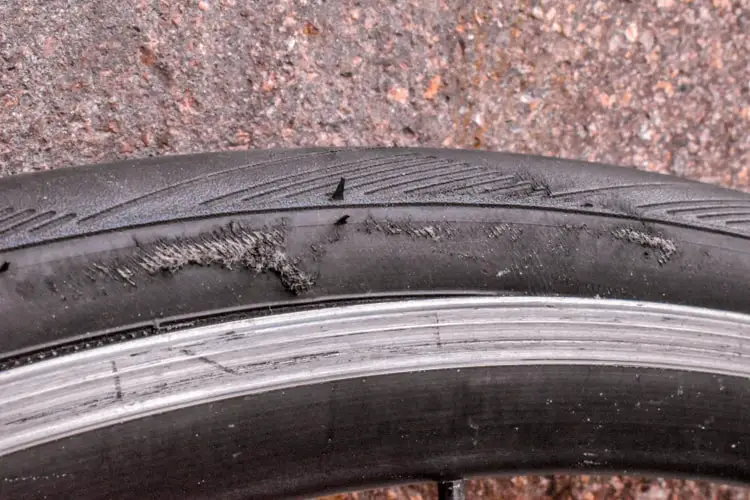When I bought my first road bike, I immediately replaced both tires as they were worn out. I put on a fresh pair and started wondering when will I need to change them again.
On average, cyclists change their tires after 2756 miles. High-end tires tend to last longer than low-end brands, as the rubber used is more quality. Cuts, cracks, and exposure to the sun can shorten tire life expectancy.
You can track the mileage of the current pair of tires, but knowing what indicators you should pay attention to is a way better and less stressful option.
What is the real mileage I can expect from tires?
Expected numbers provided by the manufacturer and reality often don’t go hand in hand. So I went one step further and polled 174 cyclists about their experiences with a duration of tires.
I figured out that most cyclists tend to change tires later than manufacturers suggest. That was expected as tire companies want to sell more tires and thus recommend replacing them sooner, while cyclists are more budget-focused and are trying to delay buying a new set as much as they can.

The biggest percentage of cyclists replace the tires after 2000 miles. In doing so, they respect the recommendations from the manufacturer.
Cyclists that change tires after about 3500 miles represent the second largest group. I will call them conservative cyclists that are willing to take small risks to save some money in the long run.
In the middle of the two groups sits the third largest group of cyclists. About 10 percent of people told me that they replace the tires after they’ve done 3000 miles with them.
The Gaussian curve teaches us that there will always be some answers at extreme values. Few people take no risks and change tires after 500 – 1500 miles. On the other side of the curve, we have people that really don’t want to spend money and are doing 5000 – 6000 miles with the same set of tires.
What indicators should I pay attention to?
When talking to cyclists, the most common answer to my question about the habit of changing tires was that they change them when they seem worn out. That shows that even with all numbers given to you, your feeling when looking at them should be the decisive factor.
Let’s be honest, people have different notions of what a worn tire looks like – one will throw away a tire that seems fine to someone else.
Based on information by experienced mechanics, cyclists throw away a lot of still usable tires just because they look used. To prevent you from doing that, tire manufacturers came up with some solutions that will directly tell you if the tire is still good or not.
Check your tires for damages after every ride. Look for cracks, cuts, or visible protection fabric.
Objective indicators
Milage
The life expectancy of a tire is most commonly expressed through mileage. When buying a new one, you’re provided with a mileage you can expect to do without any problems.
Cheaper models will often struggle to reach given mileage and cause you many problems. I advise you to buy tires from respected brands, even if they cost a bit much. In the long run, you will save money as you won’t have to replace them every few months.
As far as mileage is concerned, I won’t go into any more details as I have already given you all the numbers you need above.
Age
Tires go bad with time, even if we have not reached the predicted mileage. The rubber becomes stiffer and no longer adheres to the ground the way it’s supposed to. As a result, it will lose grip, leaving you with less control.
Cycling tires’ life expectancy is around five years, but some will start to fail as soon as after three years. Important factors that will play a role in tires’ life expectancy are weather, temperature, and direct sunlight.
Store your tires in a dry and cool place. Also, keep them away from the direct sunlight as that will speed up tire degradation.
TWI

Most cyclists don’t exactly keep track of how many miles they did with the current set of tires or how long ago they bought them. So tire manufacturers started integrating Tire Wear Indicator or TWI.
The look of it differs from brand to brand, but in most cases, these are two tiny holes on the surface marked with TWI and a triangle on the side of the tire. As a tire wears down, the holes will get shallower, and when they’re gone completely, it’s time to get rid of the tire.
Subjective indicators
Objective indicators are good as they tell you what to expect from the tire, but they often don’t paint the whole picture. In reality, there are a lot of factors that influence the rate at which a tire is wearing down.
It’s recommended you judge tire condition by some subjective indicators.
Increased number of flat tires
It’s annoying when you get a flat tire mid-ride, and it’s even more annoying that this is happening on every ride lately. The cause of the problems is the worn-out tire, and it’s time to replace it.
The increased number of flat tires is one of the main indicators that your tire is at the end of its journey. The tire will get thinner with mileage and won’t defy all the sharp little objects on the floor. Even the smallest rocks, glass shards, and potholes will become a problem and a potential threat for a flat.
Less control when riding
We already talked that the tire will stiffen with age and therefore reduce the grip. That will give you less control over your bike, which can be dangerous, especially on descends.
The tire is also losing grip with wearing out. Some road tires have patterns on the tread that you can use as a wear indicator, but most have a smooth surface. So we’re stuck with our feelings on a bike.
If the tire looks OK, but you feel your bike is not going where you want or responds with a delay, the tire might have lost its grip. Buy a new one as soon as possible, and you’ll gain back control over your bike.
Visual damages

The most obvious indicator that you need to replace your tires is visual damage. Cuts, holes, or cracks indicate that the time for new tires has come.
You get unlucky and ride over a sharp object from time to time. A flat tire is inevitable, but there is a possibility that even the outer layer is damaged. You can cover the hole with a folded dollar bill to get home, but replace the tire before your next journey.
You can also find cracks on a tire. They occur on the sidewall and are usually the result of riding with low tire pressure. If they’re not too deep, you can continue using the current tire, but it still might be worth considering going shopping for a new one.
Another sign that shows it’s time to replace tires is visible protection fabric located under the tread. The tire will not offer any grip on that spot, which can be dangerous. There will also be more chances of a flat tire, as the inner tube is not adequately protected.
Swapping front and rear tire
The front and rear tires are wearing out at a different rate. The cyclist’s weight is not evenly distributed between both tires as the rear carries most of it. Therefore the rear tire wears out at a higher rate than the front one.
You will need to replace the rear tire earlier than the front. Some like to replace them together, but there’s no good reason if the front tire is still usable.
The front tire is more important than the rear as it provides you with the majority of the grip. Worn out front tire must be replaced as soon as possible and only with a brand new tire.
On the other hand, you can replace the rear tire with a used one. While I would still recommend buying a new one, some people tend to save a few bucks by swapping the front and rear tires.
The still usable front tire can replace the worn rear tire, but the rear tire cannot replace the front tire. If you decide to replace the rear tire with the front, you must put a brand new tire to the front; otherwise, the accident is inevitable.
This trick can save you a few dollars per year, but it poses a certain threat. I would rather spend $50 per year more to ensure that the tire will not fail me when I need it the most.
How much do new tires cost?
The price range of the tires is considerable. You can get the cheapest models for as low as 10 dollars, while the high-end tires will cost you 250 dollars.
I don’t recommend buying one or the other.
I’m buying tires in a 40 – 70 dollars range, and you should do the same. You’ll get a quality tire that won’t bail on you after 100 miles, but you might not be as fast as with high-end tires.
Currently, I’m using Continental UltraSport tire. It’s on the cheaper side, and I will most definitely upgrade when I get a new pair. While they’re not bad, they’re not as good as they could be for a few bucks more.
I recommend you get a Continental Gatorskin or a Continental Grand Prix 5000, which are available on Amazon. They cost a bit more but are still in a designated price range.
With them, you will get a tire that is one or two quality levels above my tire. That means you can expect better grip and less friction, which results in higher speed at the same power. But above all, you will get a longer life expectancy.

